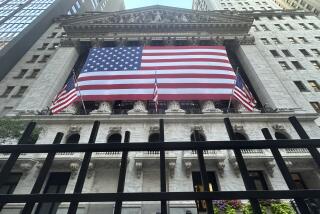Dow Climbs 7.88 Despite ‘Witching Hour’ Wariness
- Share via
NEW YORK — The stock market settled for some spotty gains today at the close of a quiet session.
The Dow Jones average of 30 industrials rose 7.88 to 2,695.72.
Advancing issues held a narrow edge on declines at the New York Stock Exchange, with 740 up, 668 down and 531 unchanged.
Big Board volume totaled 144.41 million shares, against 145.06 million in the previous session.
The NYSE’s composite index gained .52 to 186.20.
Much of the financial world’s attention was focused on Friday, when the markets have a date with the quarterly “triple witching hour” involving a set of expiring options and futures on stock indexes.
The witching hour has acquired a reputation for unpredictable turbulence, which tends to discourage traders from taking positions before it happens.
Also on the agenda for Friday are several reports from the government on the state of the economy, including industrial production and the producer price index of finished goods for February.
Brokers said investors seemed fairly confident that the data would support recent hopes that the economy could recover from its recent slowdown without having to undergo a full-scale recession.
Bond prices lost ground in slow early trading today in advance of the release of three key economic reports by the government on Friday.
The Treasury’s benchmark 30-year bond was down 1/4 point, or $2.50 per $1,000 face amount, around midday. Its yield, which rises when prices fall, was up to 8.63% from 8.60% late today.
Kevin Flanagan, a money market economist with Dean Witter Reynolds Inc., said traders may have sold to take profits after weak auto sales inspired a buying spree Wednesday that sent the price of the long bond up a full point.
A drop in the West German bond market also hampered U.S. trading, he said.
But he said activity was mostly quiet before the scheduled release Friday of figures for February producer prices, housing starts and industrial production.
Analysts forecast that the Producer Price Index would decline about 0.4% overall, but increase 0.3% to 0.4% excluding the volatile food and energy sectors.
Inflation erodes the value of fixed-income securities such as bonds, and Flanagan said the number probably would be viewed as a slight negative because of the overall increase. Energy prices have been skittish because of unseasonably warm weather.
In the secondary market for Treasury bonds, prices of short-term governments were down 1/16 point to 1/8 point, intermediate maturities were 5/32 point lower, and long-term issues traded down 7/32 point to 5/16 point, according to Telerate Inc., the financial information service.
The movement of a point is equivalent to a change of $10 in the price of a bond with a $1,000 face value.
The Shearson Lehman Hutton daily Treasury bond index, which measures price movements on all outstanding Treasury issues with maturities of a year or longer, declined 1.41 to 1,147.30.
Yields on three-month Treasury bills were unchanged at 8.19% as the discount rose 2 basis points to 7.94%. Yields on six-month bills inched up to 8.29% as the discount gained 1 basis point to 7.87%. Yields on one-year bills rose to 8.41% as the discount gained 2 basis points to 7.81%.
A basis point is one-hundredth of a percentage point. The yield is the annualized return on an investment in a Treasury bill. The discount is the percentage that bills are selling below the face value, which is paid at maturity.
The federal funds rate, the interest rate banks charge each other on overnight loans, was quoted at 8 1/4% at midday, down from 8 3/16% late Wednesday.
More to Read
Inside the business of entertainment
The Wide Shot brings you news, analysis and insights on everything from streaming wars to production — and what it all means for the future.
You may occasionally receive promotional content from the Los Angeles Times.








